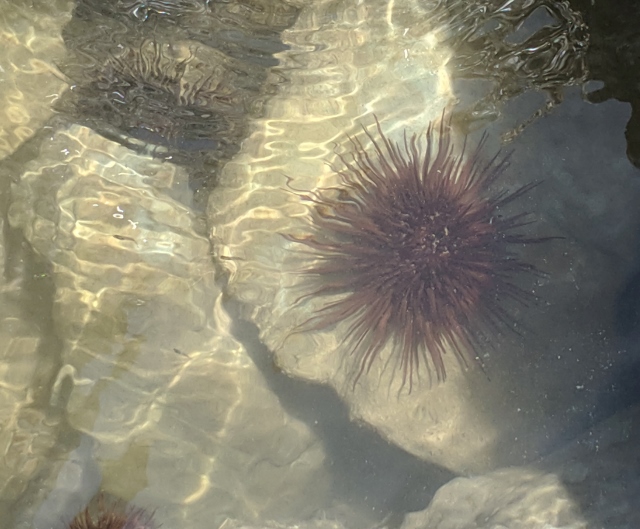by M. Kathy Raines

Lace-trimmed waters crash, swirling among jumbled blocks of granite, exploding in shimmering mist. Carpets of bright green algae glimmer in sunlight. Terns and pelicans criss-cross skies, plummeting for fish.
The jetties at Isla Blanca Park vibrate with life. Octopuses ooze through crevices. Sea urchins rest in washes between rocks. Sea hares, often called sea slugs, gently undulate in the surf. Turtle heads pop up, and wheels of dolphins feed. Great blue herons, pelicans and egrets groom, rest, eyeball prey or await treats discarded by anglers. One day, a rarely appearing masked booby sat nonchalantly upon a stump.
Among creatures regularly spotted on and near the jetties are three invertebrates of different phyla: sea hares, which, though they lack shells, are mollusks; sea urchins, which, having a hard, spiny covering, are echinoderms, and barnacles, which are arthropods, in the subphylum crustacea.


The slug-like mottled sea hare (Aplysia brasiliana) flaps its “wings” gracefully in the surf. These “wings”, which fold over its back, are an extension of its foot, which a mollusk uses for locomotion.
Two ear-like structures, rhinophores—which resemble the ears of a hare—inspire the sea hare’s name. Its mottled color varies, the hue dependent upon the color of algae it eats. Spotted white or yellow, it may be streaked with black or brown. Though unnoticeable, a thin internal shell protects its organs. Its mantle cavity, or double fold of its protective mantle, encloses a space containing its gills, anus and other organs.
Rather than a central brain, it has ganglia, groups of nerve cells. Its open circulatory system pumps blood into sinuses or sacs, rather than vessels. Its simple eyes can only distinguish light from darkness. Tentacles along the sides of its mouth, along with its rhinophores, detect chemicals.
Sea hares, with rasp-like tongues, consume algae, making them popular pest-eaters in aquariums.
Though a sea hare appears defenseless, its predators—anemones, fish and crustaceans—may be repelled by its noxious mucous coating. When threatened, it discharges, from separate glands, a substance called opaline and an acidic fog of purple ink which confuses predators, apparently impairing their sense of smell. The ink is harmless to humans.
Being hermaphroditic, sea hares can mate as males or females. The creature lays perhaps half a billion eggs in a gelatinous ribbon along the shore. Then, like its fellow mollusk, the octopus, it dies.
Sea hares live alone or in pairs along rocky, algae-coated habitats. One commonly sees them in late spring and summer, when they gather to breed.
The name sea urchin comes from Middle English “urcheon” meaning “hedgehog”, a spiny mammal. I saw corpses of the Atlantic purple sea urchin (Abacia punctulate)—beautifully patterned and symmetrical, like Christmas ornaments—in shops before I ever observed these purplish beauties pasted to granite or between boulders, spines wiggling in the puddles. And every summer, collectors pluck them from rocks, tossing them into buckets. Woe to the creature with a decorative corpse.
A bumpy shell of fused plates, a test, encircles this globular creature. A water vascular system controls its tubular feet, which emerge from holes and end in suction cups. The creature moves about on these, assisted by its spines. It can right itself if flipped over.
The sea urchin’s mouth is underneath, its genital pores and anus on top. Lips, embedded with bony tissues, surround its mouth, protecting gill openings. It grasps and tears its food—algae and rock-dwelling organisms—using a jaw with arrow-shaped plates called pyramids. Sea urchins have a beak-like structure called Aristotle’s Lantern, made up of five hard teeth-like plates, with which it scrapes algae from rocks. These structures regenerate if worn away.
A nerve ring surrounding a sea urchin’s mouth serves as a brain. It has no eyes but reacts negatively to light. It is sensitive to touch and to various chemicals.
Though sharp spines protect it from most predators, powerful waves or jaws can break a sea urchin. Lobsters, birds, eels, starfish and others manage to feed on them, having adapted useful claws, teeth and pincers to handle spines. Sea urchins hide themselves in crevices and may even dig their own holes, wearing away rocks.
Small grooming organisms live symbiotically between urchins’ spines, keeping them clean and free from damaging organisms.
Female sea urchins release millions of transparent eggs at once, which males find and fertilize. Unlike their parents, larvae are bilaterally symmetrical.
Some value sea urchins—particularly their gonads, called uni, from Japanese,—as an ingredient in a fine sushi feast.
Scientists have long prized sea urchins for research, especially in embryology, because of their transparent, quickly-developing, manipulatable eggs. Their use has advanced knowledge in fetal alcohol syndrome, anti-convulsant drugs, heredity and toxicity of chemicals in marine waters.
Several genera and species of barnacles adorn our jetties, one of them being the purple striped barnacle (Balanus trigonus).
An adult barnacle is stationary. Six fused triangular plates separated by vertical white ridges make up its conical purple shell. Small internal plates function as a door which, when the tide is out, the barnacle closes to preserve moisture. When the tide comes in, plates open, and its feathery legs filter plankton from the water.
Barnacles are hermaphrodites—a convenience since they cannot move. Any adjacent adults can mate.
Barnacle larvae, unlike their parents, are mobile creatures that, for about a month, swim and develop as they filter phytoplankton from the water. In a larva’s last stage, called cypris, it drifts, choosing a surface upon which to affix itself for life. Upon finding it, the cypris secretes cement through the ducts of two cement glands into its adhesive disks. The cypris embeds itself and metamorphosizes into a barnacle. And there it remains.
Enjoy the jetties, a rich habitat where we can observe and walk among our fellow creatures.

